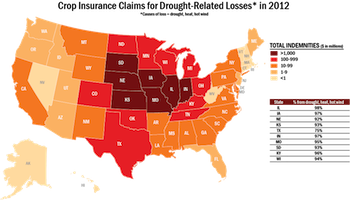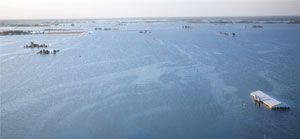Over the past few weeks, we’ve watched the devastating federal financial impact of climate change add up to $1 billion so far this year fighting western forest fires, but that number doesn’t compare to government spending for crop losses caused by extreme weather.
In 2012, the Federal Crop Insurance Program has paid a record $17.3 billion in claims – higher than its previous record of $10.8 billion in 2011, according to the Natural Resources Defense Council (NRDC).
In 2012, 80% of payments have been for crops lost to heat, drought or high wind, says NRDC.
The top 10 states that have been receiving payments are:
- Illinois (98% of all crop losses) $3,011,443,799
- Iowa (97%) $1,924,444,160
- Indiana (97%) $1,130,302,660
- Kentucky (96%) $454,380,256
- Missouri (95%) $1,098,310,111
- Wisconsin (94%) $372,479,370
- South Dakota (93%) $1,029,780,352
- Kansas (93%) $1,273,662,944
- Nebraska (92%) $1,427,738,976
- Texas (75%) $974,548,606

“The Federal Crop Insurance Program has failed farmers and taxpayers by ignoring water challenges,” says Claire O’Connor, NRDC Agricultural Water Policy Analyst. “The program was designed to be a safety net, not a subsidy for increasingly risky practices and less sustainable food production. We need to empower farmers to invest in low risk, water-smart practices that are proven to reduce crop losses.”
Better Investment: Incentives for ‘Water Smart’ Farming Techniques
At least 70% of US cropland – more than 282 million acres – are insured under the federal program, a public-private partnership between the US Department of Agriculture’s Risk Management Agency and private insurance companies. It is the most expensive US farm subsidy program.
Clearly, these policies need to switch to incentives for American farmers that build soil health and better manage water, says NRDC.
“Farmers can apply their own skills to build healthy soil, reduce the worst effects of climate change, and rein in the skyrocketing costs of this program,” says Gabe Brown, a Great Plains farmer and champion of better soil management. “Healthy soil is one of the most effective and time-tested insurance policies we have.”
Three practices NRDC advocates in its "Soil Matters" analysis are using:
Cover crops: Crops grown specifically to build soil health and increase biodiversity, especially on farms growing major commodity crops. Farmers who use this method have higher average yields this year than those who have not, and the benefit is most pronounced in areas hardest hit by drought.
No-till farming: Farmers plant directly into the stubble from the previous year’s crop rather than plowing it up. The stubble acts like mulch, retaining moisture, suppressing weeds and improves a field’s ability to support higher yields. In 2010, corn farmers who used no-till were 30% less likely to file a crop insurance claim.
Improved irrigation scheduling: Irrigating based on soil needs rather than automatic scheduling saves a lot of water.
Although the catastrophic 2012 drought has eased in many parts of the US, it is lingering in the south and west. And this spring, many farmers had the opposite problem, when they faced one of the wettest springs on record – destroying crops like watermelons, peaches and wheat.

Either way, the effects of extreme weather and climate change on farming aren’t likely to let up, underscoring the need for better soil management practices – that also result in better water absorption, less runoff and reduced flooding.
View more data and analysis about US crop losses, down to the county level:
